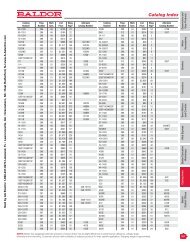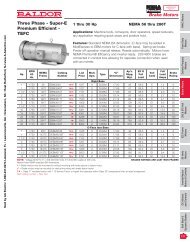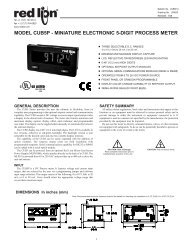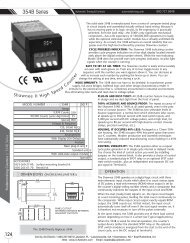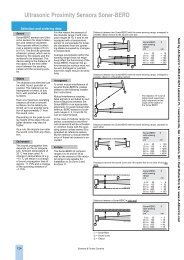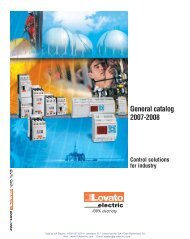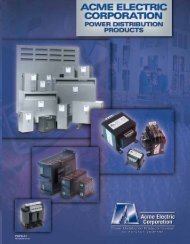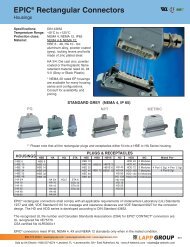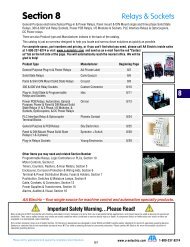You also want an ePaper? Increase the reach of your titles
YUMPU automatically turns print PDFs into web optimized ePapers that Google loves.
5<br />
0<br />
8<br />
0<br />
8<br />
0<br />
8<br />
0<br />
<strong>API</strong> 4059 G<br />
Installation and Setup<br />
Strain Gauge<br />
ELECTRICAL CONNECTIONS<br />
WARNING! All wiring must be performed by qualified personnel only.<br />
This module requires an industry-standard 11-pin socket. Order <strong>API</strong> 011 or finger-safe<br />
<strong>API</strong> 011 FS socket.<br />
Power Input Terminals – The white label on the side of the <strong>API</strong> module will indicate<br />
the power requirements. AC power is connected to terminals 1 and 3. For<br />
DC powered modules, polarity MUST be observed. Positive (+) is wired to terminal<br />
1 and negative (–) is wired to terminal 3.<br />
Strain Gauge Input – Refer to strain gauge manufacturer’s data sheet for wire<br />
color-coding. Polarity must be observed when connecting the signal input. The<br />
positive connection (+) is applied to terminal 4 and the negative (–) is applied to<br />
terminal 5.<br />
Excitation Voltage – CAUTION: Never short the excitation leads together. This<br />
will cause internal damage to the <strong>API</strong> 4059 G. Refer to strain gauge manufacturer’s<br />
data sheet for wire color-coding. Terminals 7 and 8 provide connections<br />
for the DC voltage that is used to excite the strain gauge load cell. Polarity must<br />
be observed when connecting the Excitation Output. The positive connection (+)<br />
is applied to terminal 7 and the negative (–) is applied to terminal 8. Connect the<br />
sense leads to terminal 6. If no sense lead is available, connect pin 6 to pin 7.<br />
Signal Output Terminals – Polarity must be observed when connecting the signal<br />
output to the load. The positive connection (+) is connected to terminal 9 and<br />
the negative (–) is connected to terminal 10.<br />
Strain<br />
Gauge<br />
Signal Input<br />
4 (+)<br />
5 (–)<br />
6<br />
8(–)<br />
Socket top view<br />
AC or DC (–)<br />
Power Input<br />
AC or DC (+)<br />
<strong>API</strong> 4059 G typical wiring<br />
Excitation Fine Adjust<br />
RANGE SELECTION<br />
The <strong>API</strong> 4059 G is configurable to your<br />
Volt/Curr<br />
exact input and output requirements.<br />
Excitation<br />
Select<br />
Ranges are listed on the module labels<br />
I V Output Offset Range<br />
and below. See www.api-usa.com<br />
A B C D E<br />
C<br />
C<br />
C<br />
or contact factory for special<br />
ranges.<br />
Four rotary switches and a slide switches<br />
on the side of the module are used<br />
to select input and output ranges.<br />
4059G<br />
1. See table and set Excitation rotary switch C to desired excitation voltage.<br />
Switch A to V<br />
A to I<br />
Sense +<br />
Excitation<br />
Sense –<br />
Jumper 6 & 7 for bridges without sense leads<br />
7(+)<br />
3<br />
2<br />
1<br />
11<br />
10<br />
9<br />
6<br />
4<br />
3<br />
7<br />
8<br />
2<br />
9<br />
1<br />
7<br />
A<br />
9<br />
PLC,<br />
(–) (–) Display,<br />
Recorder,<br />
(+) (+) Etc.<br />
Excitation Voltage 10 V 9V 8 V 7 V 6 V 5 V 4 V 3 V 2 V 1 V 0 V<br />
Switch C A 9 8 7 6 5 4 3 2 1 0<br />
2. Set Volt/Curr switch A to voltage (V) or current (I) depending on output type.<br />
3. From the table, find the rotary switch combination that match your input/output<br />
ranges and set rotary switches B, D, and E.<br />
4. The Excitation Fine Adjust, Zero, Span and Test Range potentiometers can<br />
now be adjusted for the desired output range.<br />
<strong>API</strong> 4059 G INPUT RANGES<br />
Rotary 0-5 0-10 0-20 0-25 0-30 0-40 0-50 0-100 0-200 0-250 0-400<br />
Switches mV mV mV mV mV mV mV mV mV mV mV<br />
BDE BDE BDE BDE BDE BDE BDE BDE BDE BDE BDE<br />
O 0-1 V 002 00A 003 006 00E 00B 000 008 001 004 009<br />
UTPUT 0-2 V 802 80A 803 806 80E 80B 800 808 801 804 809<br />
0-4 V 102 10A 103 106 10E 10B 100 108 101 104 109<br />
1-5 V 602 60A 603 606 60E 60B 600 608 601 604 609<br />
0-5 V 902 90A 903 906 90E 90B 900 908 901 904 909<br />
R 0-10 V 302 30A 303 306 30E 30B 300 308 301 304 309<br />
AN ±5 V 402 40A 403 406 40E 40B 400 408 401 404 409<br />
G ±10 V 502 50A 503 506 50E 50B 500 508 501 504 509<br />
ES 4-20 mA 702 70A 703 706 70E 70B 700 708 701 704 709<br />
0-20 mA 302 30A 303 306 30E 30B 300 308 301 304 309<br />
<strong>API</strong> maintains a constant effort to upgrade and improve its products. Specifications<br />
are subject to change without notice. Consult factory for your specific requirements.<br />
6<br />
5<br />
B<br />
4<br />
D<br />
3<br />
E<br />
F<br />
2<br />
1<br />
7<br />
A<br />
9<br />
6<br />
5<br />
B<br />
4<br />
D<br />
3<br />
E<br />
F<br />
2<br />
1<br />
7<br />
A<br />
9<br />
6<br />
5<br />
B<br />
4<br />
D<br />
3<br />
E<br />
F<br />
2<br />
1<br />
CALIBRATION<br />
Top-mounted, Zero and Span potentiometers can be used should fine-tuning of<br />
the output be necessary. An excitation voltage fine adjust potentiometer is located<br />
on the side of the module.<br />
1. Apply power to the module and allow a minimum 20 minute warm up time.<br />
2. Using an accurate voltmeter across terminals 7 and 8, adjust the excitation<br />
voltage fine adjust potentiometer for the exact output desired.<br />
3. Provide an input to the module equal to zero or the minimum input required<br />
for the application.<br />
4. Using an accurate measurement device for the module output, adjust the<br />
Zero potentiometer for the exact minimum output desired. The Zero control<br />
should only be adjusted when the input signal is at its minimum. This will produce<br />
the corresponding minimum output signal.<br />
5. Set the input at maximum, and then adjust the Span pot for the exact maximum<br />
output desired. The Span control should only be adjusted when the<br />
input signal is at its maximum. This will produce the corresponding maximum<br />
output signal.<br />
6. This is a basic calibration procedure and does not account for offsets or tare<br />
weights. To achieve optimum results, it is recommended that the <strong>API</strong> 4059 G<br />
be calibrated by an accurate bridge simulator before being placed in service.<br />
7. Offset switch D can be used to cancel or tare non-zero readings by offsetting<br />
the low end of the input range.<br />
Switch position 0 results in no offset.<br />
To raise the output zero, rotate switch D clockwise from 1 through 7 until the<br />
zero potentiometer is within range of your desired output.<br />
To lower the output zero, rotate switch D through ranges 9 through F until the<br />
zero potentiometer is within range of your desired output. This range is often<br />
used for elevated input ranges.<br />
TEST BUTTON<br />
The Test pushbutton may be set to provide the desired output when depressed.<br />
This will drive the device on the output side of the loop (a panel meter, chart<br />
recorder, etc.) with a known good signal that can be used as a system diagnostic<br />
aid during initial start-up or during troubleshooting. It can be adjusted to vary<br />
the output signal from 0 to 100% of the calibrated output range. When released,<br />
the output will return to normal.<br />
Turn the multi-turn Test Range potentiometer while holding the Test Switch<br />
depressed until the desired output test level is reached.<br />
OPERATION<br />
Strain gauges and load cells are normally passive devices that are commonly<br />
referred to as “bridges” due to their four-resistor Wheatstone bridge configuration.<br />
These sensors require a precise excitation source to produce an output that<br />
is directly proportional to the load, pressure, etc. that is applied to the sensor.<br />
The exact output of the sensor (measured in millivolts) is determined by the sensitivity<br />
of the sensor (mV/V) and the excitation voltage applied. For example, a<br />
load cell rated for 3 mV/V sensitivity and 10 VDC excitation will produce an output<br />
of 0 to 30 mV for load variations from 0 to 100%.<br />
3 mV/V sensitivity X 10 VDC excitation = 30 mV range<br />
An additional input, the “sense” lead, monitors the voltage drop in the sensor<br />
leads and automatically compensates the excitation voltage at the module in<br />
order to maintain a constant excitation voltage at the sensor.<br />
The <strong>API</strong> 4059 G provides the excitation voltage to the sensors and receives the<br />
resulting millivolt signal in return. This input signal is filtered and amplified, then<br />
offset, if required, and passed to the output stage. Depending on the output configuration<br />
selected, a DC voltage or current output is generated.<br />
GREEN LoopTracker ® Input LED – Provides a visual indication that a signal is<br />
being sensed by the input circuitry of the module. It also indicates the input signal<br />
level by changing in intensity as the process changes from minimum to maximum.<br />
If the LED fails to illuminate, or fails to change in intensity as the process<br />
changes, this may indicate a problem with module power or signal input wiring.<br />
RED LoopTracker Output LED – Provides a visual indication that the output<br />
signal is functioning. It becomes brighter as the input and the corresponding output<br />
change from minimum to maximum. For current outputs, the RED LED will<br />
only light if the output loop current path is complete. For either current or voltage<br />
outputs, failure to illuminate or a failure to change in intensity as the process<br />
changes may indicate a problem with the module power or signal output wiring.<br />
Sold by <strong>AA</strong> <strong>Electric</strong> 1-800-237-8274 Lakeland, FL • Lawrenceville, GA • Greensboro, NC • East Rutherford, NJ www.A-Aelectric.com



